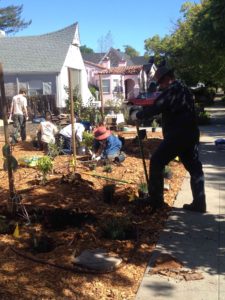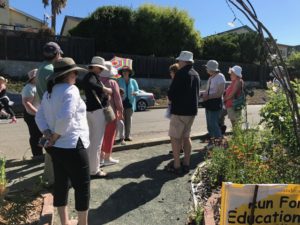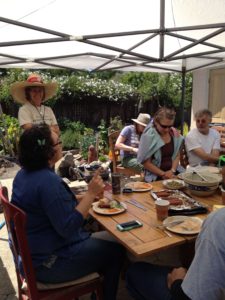By Allison Nagel
Sometimes the hardest thing about finding something new is wrapping your brain around how to approach it. When it comes to permaculture and sustainable gardening, no online resource can replace seeing, walking through, discussing and getting down on hands and knees to install a food forest. That’s where my recent experience with Sustainable Solano has made such a difference.

Digging swales at Enchanted Garden, Day 3 of installations.
Before April, I had never dug a swale in my life. The thought of redirecting downspouts and digging swales was intimidating, as was the wonder and worry about what to plant where. Participating at the Enchanted Cottage Garden installation in Vallejo changed that, because it helped create the muscle knowledge of digging, filling and planting an actual food forest. With so many people involved, the work was fast and fun, and I picked up so many tips on creating a swale, laying sheet mulch, and planting trees, edibles and beneficial plants.

Food Forest Keeper Heather welcomes a tour group at the 7 Food Forest Tour on May 20th.
Seeing a garden at its very beginning was one experience, and the May 20 tour of seven gardens in Benicia showed what can happen in a year or two. Trees had flourished, producing fruit, and vines of raspberries threatened to take over their designated corners. In some cases, certain plants had not survived conditions that were too wet or too dry — and the forest keepers who owned and shared their gardens talked about relocating, replacing and replanting. Often the refrain came up that the gardens were “sink or swim” with plants best suited to the tops of hills, the sunny spots or the wetter spots given their chance to settle in and grow, but not coddled or forced.
One thing I’ve also learned that is just as valuable as any landscape or plant knowledge: There is a community of pretty amazing people doing this.

Sharing lunch and each other’s company on Installation Day 2 at The Ripple Effect.
During the time spent on the Enchanted Cottage Garden, I got to know the other volunteers, hear about what they were doing in their own homes and why they were volunteering on the project. We talked greywater and plants, but also about neighbors and community. I was sad to say goodbye on the last day and hope to reconnect at future events and projects.
In Benicia, each forest keeper who opened their gates to those of us on the tour was open and welcoming in discussing their gardens, offering up plants and offering advice. They shared how often they water their fruit trees, what struggled in one location and thrived in another, how they collected and let their gardens self-seed or how they were taking the ideas from their food forests and translating them into other parts of their yard. I spoke with some about how sharing the garden’s bounty with neighbors has fostered a stronger sense of community.
I left that tour with notes on each garden, a rough sketch of ideas for my own yard and a pivot in what I want to focus on first, moving my ambitions from the backyard to the front with what we might be able to start planting that could draw in neighbors (though, trust me, I certainly have plans for the backyard, too).
And, whether it’s finding a local source for wood chips, floating a question about plants or seeking out programs to further my own understanding, I know that there is Sustainable Solano and this community of keepers always there to help.

